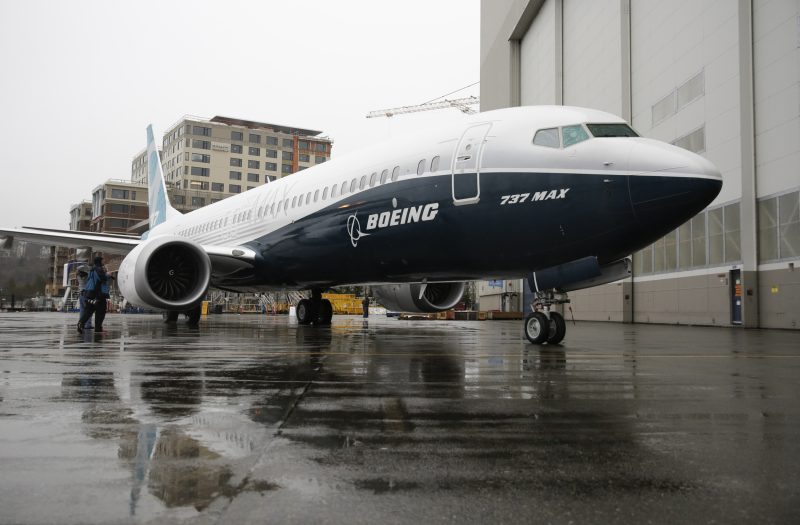Boeing’s plan to get back on solid footing after a series of quality flaws in its bestselling jet suffered a near disaster when a plane panel blew out during an Alaska Airlines flight, leaving a gaping hole in row 26.
The Federal Aviation Administration on Saturday, less than a day after the accident, ordered a grounding of most 737 Max 9 planes, affecting some 171 aircraft worldwide, so they can be inspected. On Sunday, the agency said, “they will remain grounded until the FAA is satisfied that they are safe.”
Several factors onboard Alaska Airlines Flight 1282 that turned back Portland, Oregon, minutes into the flight to Ontario, California, on Friday afternoon — including its lower-than-cruising altitude and unoccupied seats where it mattered most — helped avoid serious injury, or worse, for the flight’s 171 passengers and six crew.
The force from the event was so violent it ripped some headrests and seatbacks out of the cabin, blew open the cockpit door, and ripped off the first officer’s headset, according to early details of the federal investigation.
A schoolteacher in the Portland area found the door plug in his backyard, the National Transportation Safety Board said late Sunday.
The terrifying incident means renewed scrutiny for Boeing, which has been working to get its 737 Max program back on track after two fatal crashes, the Covid-19 pandemic’s supply chain havoc and a series of smaller but troubling quality issues in recent months.
The 737 Max 9 flown by Alaska Airlines on Friday was delivered less than three months ago.
“The fact that it was a practically brand-new aircraft is a cause for concern,” said Jim Hall, a former chairman of the National Transportation Safety Board.
United Airlines and Alaska Airlines, the largest operators of the 737 Max 9, on Saturday said they suspended flights with those planes, forcing the carriers to cancel more than 400 flights.
Boeing’s leadership has spent roughly five years regrouping after the 2018 and 2019 fatal crashes of its smaller and more popular Boeing 737 Max 8, which prompted a worldwide grounding of both the Max 8 and Max 9, the two types flying commercially.
Regulators began clearing the planes to fly again in late 2020, and Boeing has won hundreds of new orders for the planes as airlines trip over each other to secure new jets, which are sold out for most of this decade at Boeing and rival Airbus.
Boeing has been trying to ramp up production of the workhorse jet while simultaneously stamping out quality issues such as rudder system bolts that were possibly loose and holes that were incorrectly drilled on certain aircraft. Those defects prompted additional inspections and in some cases slowed down deliveries to airlines.
Boeing still hasn’t won regulator approval for carriers to start flying the smallest Max 7 and largest Max 10 models.
“I’ve heard from a few of you wondering if we’ve lost a step in this recovery,” Boeing CEO Dave Calhoun told Wall Street analysts on an earnings call in October. “You might not be surprised to hear that I view it as exactly the opposite. Over the last several years, we’ve added rigor around our quality processes.”
Calhoun said last month in a statement announcing a new COO that 2024 would be a “significant transitional year in our performance as we continue to restore our operational and financial strength.”
Wall Street analysts expect Boeing to post its sixth consecutive quarterly net loss when it reports results on Jan. 31, according to FactSet estimates. They also anticipate the manufacturer to be profitable this year, starting in the first quarter.
Shares of Boeing climbed close to 37% in 2023, the stock’s best percentage gain since 2017 and its first annual advance since a modest rise in 2019. The company’s shares tumbled more than 8% in premarket trading on Monday, the first trading day since the incident.
Calhoun told employees on Sunday that he’s canceled a leadership summit early this week and will instead hold an all-employee meeting on Tuesday to discuss safety.
“While we’ve made progress in strengthening our safety management and quality control systems and processes in the last few years, situations like this are a reminder that we must remain focused on continuing to improve every day,” Calhoun said in a staff memo Sunday.
Jennifer Homendy, chair of the National Transportation Safety Board, which is leading the investigation into Friday’s accident, said at a press briefing Saturday night in Portland that the probe is centered around the Alaska Airlines flight and that specific aircraft, not the entire fleet of Boeing 737 Maxes.
There will be big questions to answer about how exactly the panel blew out at 16,000 feet, putting a plane full of passengers at risk.
Fuselage supplier Spirit Aerosystems said it installed the plug door, an emergency exit door that’s cut into the plane but not intended for use under certain plane configurations, like those on United and Alaska, and is therefore sealed off. A Boeing spokeswoman declined to comment on whether Boeing is the last to seal the door before the planes are delivered to airlines, citing the ongoing investigation.
John Goglia, a former member of the NTSB and a transportation safety consultant, said that the Alaska Airlines incident will likely be a “blip” for Boeing but argued federal regulators should further scrutinize Boeing as it gears up to produce even more 737 Maxes.
“If I was the FAA, I’d say, ‘Show me six months where you don’t have any assembly problems,’” he said. “The FAA needs to slow Boeing down.”
According to Jefferies, the 737 Max 9 represents just 2% of Boeing’s backlog of more than 4,500 Max planes. It’s far less popular than the Max 8, which accounts for around 68% of the Maxes that customers have ordered from Boeing.
And while the planes will remain grounded for the time being, some safety experts don’t expect the same level of impact on the company as it saw after the 2018 and 2019 Max crashes, in which a piece of flight-control software was implicated.
Richard Aboulafia, managing director at aviation consulting firm Aerodynamic Advisory, said the problem on the Alaska Airlines plane appears to be a manufacturing defect, not an inherent design flaw.
That should make the investigation and recovery easier for Boeing, he said.
And, of course, there’s the fact that no one died following Friday’s flight in contrast to the 346 people who were killed in the 2018 and 2019 crashes.
No serious injuries were reported after the Alaska Airlines flight.
No one was seated in 26A and 26B, the window and middle seats next to the panel that blew out. The plane hadn’t yet reached cruising altitude — which can be double the 16,000 feet where the incident occurred — also helping matters, because passengers and flight attendants weren’t walking around the cabin.
“We don’t often talk about psychological injury, but I’m sure that happened here,” Homendy, the NTSB chair said Saturday night.
“We are very, very fortunate that this didn’t end up as something more tragic,” she said.



























